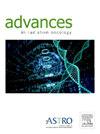超低分割辅助乳房放射治疗(±Boost)和虚拟会诊:1年患者的观点
IF 2.2
Q3 ONCOLOGY
引用次数: 0
摘要
目的2020年3月,采用为期1周的5次26 Gy超低分割乳腺辅助放射治疗方案和远程医疗,降低工作人员和患者感染COVID-19的风险。本研究描述了现实世界中超低分割1年后的毒性(包括连续增强)以及患者对这种新时间表和远程医疗工作流程的看法。方法和材料:在2020年3月至8月期间连续入组患者。在基线、3个月、6个月和1年,使用欧洲癌症研究和治疗组织生活质量问卷(EORTC QLQ) BR45记录患者报告的结果测量,包括乳房疼痛、肿胀、僵硬等。使用了没有视频的虚拟电话会议。患者被邀请使用视频在1年的医生为基础的评估,包括乳房检查。还收集了1年后患者报告的体验措施,以了解缩短的时间表和远程医疗如何影响患者体验。结果135例患者中有121例完成了至少2项评估,其中33例(25%)获得了连续改善。大多数患者在所有3个时间点报告无毒性或轻度毒性:3个月时76%,6个月时76%,1年时82%。当比较单独的5次26 Gy剂量与连续增加的5次26 Gy剂量时,1年后毒性报告没有差异。总共有94%的人认为在整个治疗过程中都得到了医疗小组的支持,只提供远程保健咨询。只有27%的人在接受乳房检查视频咨询时表示同意。结论:低分割乳腺放射治疗在1年的晚期毒性是可以接受的,即使在低分割肿瘤床增强后也是如此。患者对超分割治疗和无视频虚拟会诊的满意度较高。进一步调查有关患者接受视频咨询的医生为基础的评估,包括乳房检查,是必要的。本文章由计算机程序翻译,如有差异,请以英文原文为准。
Ultrahypofractionated Adjuvant Breast Radiation Therapy (± Boost) and Virtual Consultations: Patient Perspectives at 1 Year
Purpose
In March 2020, a 1-week ultrahypofractionated adjuvant breast radiation therapy schedule, 26 Gy in 5 fractions, and telehealth were adopted to reduce the risk of COVID-19 for staff and patients. This study describes real-world 1-year late toxicity for ultrahypofractionation (including a sequential boost) and patient perspectives on this new schedule and telehealth workflows.
Methods and Materials
Consecutive patients were enrolled between March and August 2020. Patient-reported outcome measures, including the presence of breast pain, swelling, firmness, and others, were recorded using the European Organisation for research and treatment of cancer quality of life questionairre (EORTC QLQ) BR45 at baseline, 3 months, 6 months, and 1 year. Virtual teleconferencing without video was used. Patients were invited to use video at 1 year for a physician-based assessment, including breast inspection. Patient-reported experience measures were also collected at 1 year to capture how a shortened schedule and telehealth influenced patient experience.
Results
In total, 121 of 135 patients completed at least 2 assessments, of which 33 (25%) received a sequential boost. The majority of patients reported no toxicity or mild toxicity at all 3 time points: 76% at 3 months, 76% at 6 months, and 82% at 1 year. When comparing 26 Gy in 5 fractions alone versus 26 Gy in 5 fractions followed by a sequential boost, there was no difference in toxicity reported at 1 year. A total of 94% felt supported by the medical team throughout their treatment course using telehealth-only consultations. Only 27% actually agreed to video consultation for the purpose of breast inspection when offered.
Conclusions
Ultrahypofractionated breast radiation therapy leads to acceptable late toxicity at 1 year, even when followed by a hypofractionated tumor bed boost. Patient satisfaction with ultrahypofractionated treatment and virtual consultations without video was high. Further investigation concerning the patient's acceptance of video consultations for a physician-based assessment, including breast inspection, is warranted.
求助全文
通过发布文献求助,成功后即可免费获取论文全文。
去求助
来源期刊

Advances in Radiation Oncology
Medicine-Radiology, Nuclear Medicine and Imaging
CiteScore
4.60
自引率
4.30%
发文量
208
审稿时长
98 days
期刊介绍:
The purpose of Advances is to provide information for clinicians who use radiation therapy by publishing: Clinical trial reports and reanalyses. Basic science original reports. Manuscripts examining health services research, comparative and cost effectiveness research, and systematic reviews. Case reports documenting unusual problems and solutions. High quality multi and single institutional series, as well as other novel retrospective hypothesis generating series. Timely critical reviews on important topics in radiation oncology, such as side effects. Articles reporting the natural history of disease and patterns of failure, particularly as they relate to treatment volume delineation. Articles on safety and quality in radiation therapy. Essays on clinical experience. Articles on practice transformation in radiation oncology, in particular: Aspects of health policy that may impact the future practice of radiation oncology. How information technology, such as data analytics and systems innovations, will change radiation oncology practice. Articles on imaging as they relate to radiation therapy treatment.
 求助内容:
求助内容: 应助结果提醒方式:
应助结果提醒方式:


